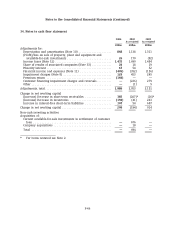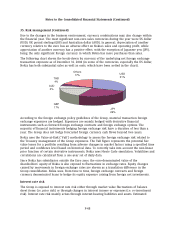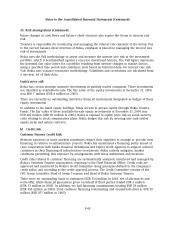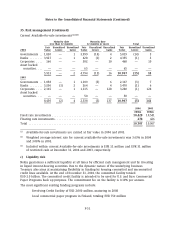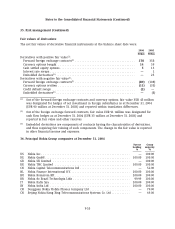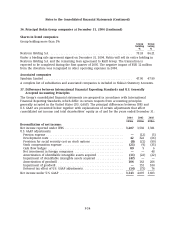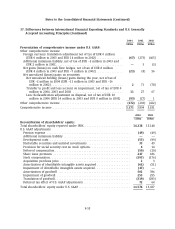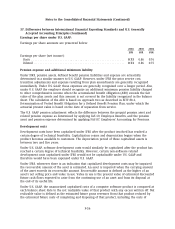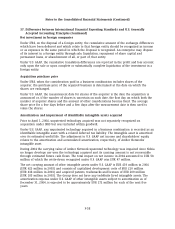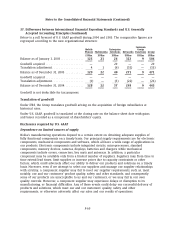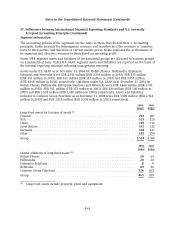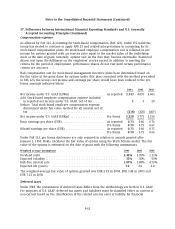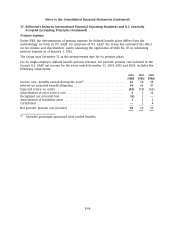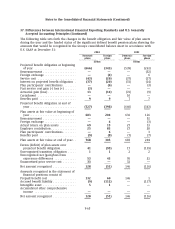Nokia 2004 Annual Report Download - page 181
Download and view the complete annual report
Please find page 181 of the 2004 Nokia annual report below. You can navigate through the pages in the report by either clicking on the pages listed below, or by using the keyword search tool below to find specific information within the annual report.
Notes to the Consolidated Financial Statements (Continued)
37. Differences between International Financial Reporting Standards and U.S. Generally
Accepted Accounting Principles (Continued)
Earnings per share under U.S. GAAP:
Earnings per share amounts are presented below:
2004 2003 2002
EUR EUR EUR
Earnings per share (net income):
Basic ........................................................ 0.73 0.86 0.76
Diluted ...................................................... 0.73 0.86 0.75
Pension expense and additional minimum liability
Under IFRS, pension assets, defined benefit pension liabilities and expense are actuarially
determined in a similar manner to U.S. GAAP. However, under IFRS the prior service cost,
transition adjustments and expense resulting from plan amendments are generally recognized
immediately. Under U.S. GAAP, these expenses are generally recognized over a longer period. Also,
under U.S. GAAP the employer should recognize an additional minimum pension liability charged
to other comprehensive income when the accumulated benefit obligation (ABO) exceeds the fair
value of the plan assets and this amount is not covered by the liability recognized in the balance
sheet. The calculation of the ABO is based on approach two as described in EITF 88-1,
Determination of Vested Benefit Obligation for a Defined Benefit Pension Plan, under which the
actuarial present value is based on the date of separation from service.
The U.S. GAAP pension adjustment reflects the difference between the prepaid pension asset and
related pension expense as determined by applying IAS 19, Employee Benefits, and the pension
asset and pension expense determined by applying FAS 87, Employers’ Accounting for Pensions.
Development costs
Development costs have been capitalized under IFRS after the product involved has reached a
certain degree of technical feasibility. Capitalization ceases and depreciation begins when the
product becomes available to customers. The depreciation period of these capitalized assets is
between two and five years.
Under U.S. GAAP, software development costs would similarly be capitalized after the product has
reached a certain degree of technical feasibility. However, certain non-software related
development costs capitalized under IFRS would not be capitalizable under U.S. GAAP and
therefore would have been expensed under U.S. GAAP.
Under IFRS, whenever there is an indication that capitalized development costs may be impaired
the recoverable amount of the asset is estimated. An asset is impaired when the carrying amount
of the asset exceeds its recoverable amount. Recoverable amount is defined as the higher of an
asset’s net selling price and value in use. Value in use is the present value of estimated discounted
future cash flows expected to arise from the continuing use of an asset and from its disposal at
the end of its useful life.
Under U.S. GAAP, the unamortized capitalized costs of a computer software product is compared at
each balance sheet date to the net realizable value of that product with any excess written off. Net
realizable value is defined as the estimated future gross revenues from that product reduced by
the estimated future costs of completing and disposing of that product, including the costs of
F-56


